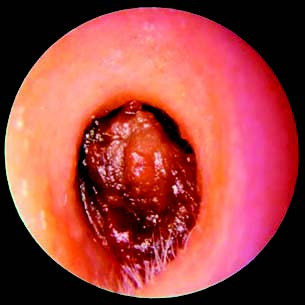Impacted cerumen is the accumulation of cerumen in the external auditory canal due to excessive secretion or impaired clearance, resulting in the formation of a mass that obstructs the canal.
Clinical Manifestations
Symptoms may include hearing loss, tinnitus, ear pain, and even vertigo. Reflexive coughing can occur due to stimulation of the auricular branch of the vagus nerve in the external auditory canal. Repeated irritation from the cerumen can lead to external otitis. On examination, brownish black or yellowish brown masses obstructing the external auditory canal can be seen.

Figure 1 Impacted cerumen
Treatment
The removal of cerumen requires meticulous care to avoid injury to the external auditory canal and tympanic membrane.
For cerumen that is mobile and does not completely obstruct the external auditory canal, cerumen forceps or a cerumen hook can be used to extract the mass. For soft cerumen, it can be separated from the canal wall and removed in portions. For hard cerumen, a cerumen hook can be used to create a gap by separating the cerumen from the posterior-superior wall of the canal. The hook is then inserted into the center of the cerumen mass, and the cerumen is slowly extracted, preferably in one piece.
For dry and hard cerumen that is difficult to remove, a 5% sodium bicarbonate solution can be instilled into the ear 4 - 6 times daily for 2 - 3 days to soften the cerumen. Once softened, it can be flushed out with saline irrigation. If external otitis is present, antibiotics should be administered to control the inflammation.
For deeply impacted cerumen or in cases where cooperation is limited, such as in children, cerumen removal can be performed under an otoscope after adequate softening. This ensures thorough cleaning of the external auditory canal while minimizing the risk of injury to the canal and tympanic membrane.